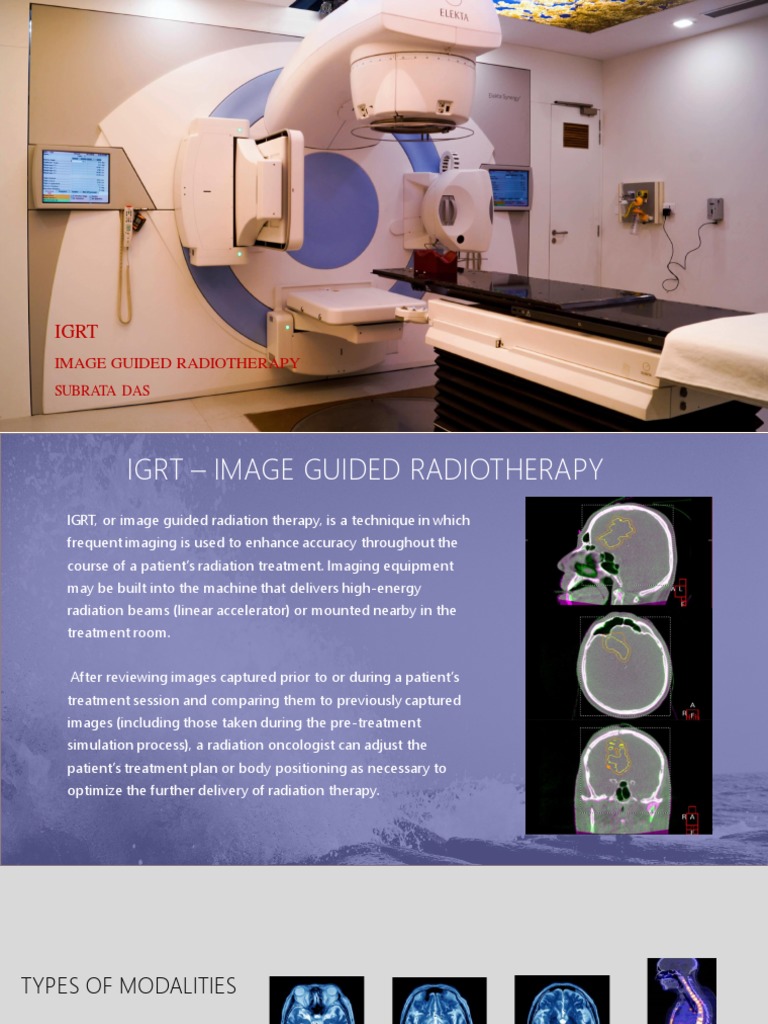Image Guided Radiotherapy (IGRT) has emerged as a pivotal advancement in the field of radiation oncology, revolutionizing the precision of cancer treatment. At the core of IGRT lies an intricate interplay between imaging technologies and treatment delivery systems that fosters enhanced accuracy and efficacy in targeting malignancies. This article aims to elucidate the essence of IGRT, its methodologies, advantages, and implications in modern therapy.
To fully appreciate IGRT, one must first comprehend the nuances of its definitional framework. IGRT is fundamentally defined as a technique that utilizes imaging, usually performed before or during radiation therapy sessions, to verify and optimize the positioning of the target tumor. In essence, it serves as a dynamic guide that aligns the patient’s anatomy with the treatment plan — a concept that resonates deeply within the realm of precision medicine.
The evolution of IGRT can be traced back to the burgeoning developments in imaging technologies over the past few decades. Originally, treatment planning relied heavily on conventional imaging modalities like X-rays and CT scans, which, while effective, lacked the real-time feedback necessary for ensuring consistent accuracy. With the advent of advanced imaging techniques—such as cone-beam computed tomography (CBCT), magnetic resonance imaging (MRI), and ultrasonography—clinicians gain access to a plethora of anatomical information that enhances their capacity to track tumor positions with remarkable precision.
Moreover, the underlying technology of IGRT incorporates sophisticated systems designed to ascertain the geometric fidelity of patient positioning. By employing fiducial markers, which are small objects placed within or near the tumor, the therapy team can achieve a high level of localization accuracy. Such markers aid in the visual corroboration of tumor placement against pre-defined coordinates, affirming that the therapeutic beam accurately targets the neoplastic tissue.
One of the compelling motivations for utilizing IGRT is its inherent capacity to compensate for anatomical changes that may occur due to various factors throughout the treatment course. For instance, factors such as weight loss, tumor shrinkage, or even organ movement during respiration can distort the original treatment plan. IGRT mitigates these issues through its adaptive nature, allowing clinicians to modify and optimize treatment based on the current patient anatomy rather than relying on static, pre-treatment images.
The advantages of IGRT extend beyond mere positional accuracy. One notable benefit is the reduction of radiation exposure to surrounding healthy tissues. By accurately pinpointing the tumor location, IGRT facilitates dose escalation to the malignancy while simultaneously sparing adjacent structures, thus enhancing the therapeutic ratio. This is particularly salient in the treatment of malignancies located in proximity to critical organs, such as the lungs, liver, or spinal cord.
Furthermore, IGRT enhances treatment outcomes, as evidenced by numerous studies that highlight improved local control rates in various cancers, particularly prostate and head-and-neck malignancies. The convergence of real-time imaging and radiation delivery not only maximizes tumor targeting but also minimizes the risk of adverse side effects, a paramount consideration in cancer therapy.
In addition to clinical advantages, IGRT embodies the principles of patient-centric care. As the healthcare paradigm shifts towards more personalized approaches, IGRT aligns with the philosophy of tailoring treatment to individual patient needs. By integrating advanced imaging techniques, oncologists can significantly involve patients in their treatment planning, empowering them with knowledge about their cancer and fostering a collaborative atmosphere between patient and provider.
Despite its myriad advantages, the integration of IGRT into clinical practice is not devoid of challenges. The technological requirements associated with implementing IGRT necessitate substantial investment in infrastructure and training. Facilities must be equipped with state-of-the-art imaging equipment, and clinicians and technicians must possess specialized training to interpret images effectively. This presents a barrier for some institutions, particularly in resource-limited settings, potentially creating disparities in access to this transformative technology.
Ethical considerations are also paramount when discussing the implications of IGRT. The intricacies of informed consent in the context of advanced imaging techniques necessitate transparent communication between healthcare professionals and patients. The potential for over-treatment or the psychological impact of uncertainty regarding imaging results warrants careful navigation, underscoring the importance of comprehensive patient education throughout the treatment process.
The future of IGRT appears promising, characterized by continued advancements in imaging technology and machine learning algorithms that may further enhance precision and efficiency. As artificial intelligence becomes increasingly integrated into radiation oncology, the potential for automated adaptation of treatment plans based on real-time imaging data may redefine the paradigms of cancer management.
In summary, Image Guided Radiotherapy epitomizes the convergence of technology and clinical practice, embodying the ideals of precision in the treatment of malignancies. Its ability to deliver precise radiation to tumors while reducing collateral damage to healthy tissues stands as a testament to its transformative power. As research continues and technology evolves, IGRT is poised to remain at the forefront of innovative cancer care, addressing the fundamental tenets of accuracy, efficacy, and compassion in the face of one of humanity’s most formidable adversaries.












